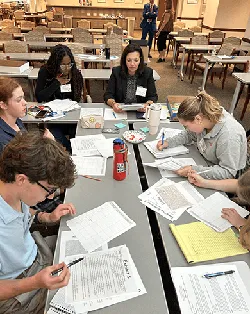Twenty-two high school students in the St. Louis area were the first to participate in a new civics education program teaching them about the federal Judiciary through a landmark Supreme Court case that originated in their hometown and local court.
“By hosting the program in the very court where a particular case began, and then immersing the students in not only the law and facts of the case but, as importantly, the people and places, the program powerfully connects students to the factual roots the case has with the students’ hometown,” said U.S. District Chief Judge Stephen R. Clark, who kicked off the national initiative at the Thomas F. Eagleton U.S. Courthouse in the Eastern District of Missouri.
The multi-day program, called The Supreme Court and My Hometown, immerses students in the analysis of facts, trials, and appeals that lead to Supreme Court decisions. During the inaugural program, students explored the constitutional questions and procedural history of Hazelwood v. Kuhlmeier, a 1988 free speech case involving student journalists at Hazelwood East High School in St. Louis.
The program was run in partnership with the Supreme Court Historical Society and the St. Louis Chapter of the Federal Bar Association.
“One of the primary missions of the Supreme Court Historical Society is to increase public knowledge about both the history of the Supreme Court and the federal Judiciary, and the importance of their independence,” said James C. Duff, executive director. “Students will see how issues of local and regional significance can have national impact as well. In this way, they also learn about how a case progresses to the Supreme Court and the role the federal courts play in the process.”

Students prepare for a moot court proceeding during The Supreme Court and My Hometown program in St. Louis.
By partnering with the Supreme Court Historical Society, federal courts can host unique experiences for students that may include educational sessions with legal mentors, teaching how to write a legal brief, putting on a student-led moot court proceeding of a landmark Supreme Court case that originated at the court, and more.
“Many students, especially in rural areas, believe the court system is so out of reach and that warps their perception on the system as a whole,” said Cordelia Elder, a high school student who participated in the St. Louis program. “It is necessary for students to learn this information, and it was such a privilege to learn it in the building it happens in.”
Students also complete a final project designed to promote their increased understanding of the impact of the hometown case. In St. Louis, students worked with the Eighth Circuit Library to design a panel display about Hazelwood v. Kuhlmeier that includes the background of the case and the impact of the Supreme Court decision. The display will be unveiled at the St. Louis Judicial Learning Center later this year.
“To the person who walks through the doors of an imposing courthouse for his or her case, courthouses can be intimidating,” Clark said. “All the more so with the Supreme Court. The program dissipates the intimidation factor by welcoming students into the courthouse over the course of a semester and connecting them with the broad array of people who work there.”
High school student Aiyla Ahmad found The Supreme Court and My Hometown both informative and rewarding.
“I gained a very important inside perspective on our court system and also learned a lot about how a case moves through the courts and makes it to the Supreme Court,” Ahmad said. “I also discovered many different jobs in the judicial branch.”
Students can apply now for June programs in Chattanooga, Tennessee, and Indianapolis, Indiana, from the Supreme Court Historical Society website. Applications are due by March 1.
To learn more about the program, contact Nicole Maffei, the director of civics education for the Supreme Court Historical Society.
Subscribe to News Updates
Subscribe to be notified when the news section is updated.


